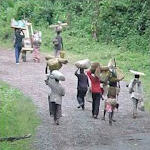 This is a summary of what was said by UNHCR spokesperson Jennifer Pagonis - to whom quoted text may be attributed - at the press briefing, on 31 August 2007, at the Palais des Nations in Geneva.
This is a summary of what was said by UNHCR spokesperson Jennifer Pagonis - to whom quoted text may be attributed - at the press briefing, on 31 August 2007, at the Palais des Nations in Geneva.
Thousands of newly internally displaced people are fleeing rising tensions and insecurity in the Masisi and Rutshuru districts of North Kivu in the eastern Democratic Republic of the Congo (DRC). The population of one of the makeshift camps at Mugunga, some 15 kilometers west of Goma, has doubled over the past three weeks, according to those staying there. Just four weeks ago, Mugunga hosted an estimated 9,000 internally displaced persons. Today, there are some 18,000.
Since December 2006, over 20 such IDP sites have mushroomed in North Kivu province as the capacity of host families to take new arrivals has been exhausted.
We are increasingly concerned by the spiralling displacement and atrocities in eastern DRC. With heightened tensions and the build-up of military forces, the situation risks turning into a humanitarian and human rights disaster.
According to our teams, more displaced people continued to arrive at various sites over the past days, as Congolese in many villages of Masisi and Rutshuru districts fear clashes between regular DRC government forces, renegade troops resisting integration into the regular army and various rebel groups.
Internally displaced people in Mugunga say they fled fearing fighting and an escalation of violence, not because of direct attacks. Since Monday, some 600 displaced people found shelter in over-crowded conditions in a school building close to Mugunga. The displaced at the Muganga site are living under precarious conditions on volcanic rock. In 1994, Mugunga was the site of a humanitarian tragedy, when hundreds of thousands of Rwandan refugees fled to the area in the aftermath of the Rwandan genocide, forming one of the largest refugee camps at that time.
Access to the displaced people is a problem for humanitarian agencies because of the worsening security situation. Whenever possible, our field monitoring teams are regularly visiting displacement areas to assess the needs.
In order to improve living conditions at the Mugunga site, UNHCR organized training yesterday for IDP leaders and local authorities in Mugunga, focusing on camp management. Our teams provided guidance on distribution of water, maintenance of shelters and latrines. Other UN agencies and NGOs are also rushing to provide household items and food rations to those displaced at Mugunga and other sites in North Kivu.
We are currently planning more projects to improve living conditions in IDP sites in North Kivu. Since December 2006, an estimated 180,000 Congolese have been newly displaced in North Kivu, including refugee movements across the border into Uganda. The latest was reported last week when some 10,000 Congolese fled to Kisoro district in south-west Uganda. In total, there are now more than 650,000 internally displaced in the North Kivu province.
<
Related articles
- • Congo Will Not Sign a 'Peace Deal' With Defeated M23 Rebels, Government Says (November 6, 2013)
- • Kabila Congratulates Congo Army for Defeating M23 Rebels (October 30, 2013)
- • Advancing Congo Troops Take Control of Rumangabo From M23 Rebels (October 28, 2013)
- • Congo Army Liberates Rutshuru, Kiwanja and Kibumba From M23 Rebels (October 27, 2013)
- • Congo Army Dislodges M23 Rebels From Strategic Town of Kibumba (October 26, 2013)
- • Congo Army Takes Control of Kibumba After Fighting With M23 Rebels Resumes (October 25, 2013)
- • U.S. Sanctions Rwanda Over Use of Child Soldiers by M23 Rebels (October 4, 2013)
- • Dozens of M23 Rebels Killed by Congo Army in Renewed Fighting (August 22, 2013)
- • M23 Arrests 110 People Accusing Rebels of Looting At Rally (July 27, 2013)
- • M23 Rebels Kill, Rape Civilians in Eastern Congo: Human Rights Watch (July 22, 2013)
- • M23 Rebels in Disarray in Eastern Congo, Says Government Spokesman (July 19, 2013)
- • U.S. Sanctions M23 Rebel Leaders (December 18, 2012)
- • U.S. Treasury Department Sanctions M23 Rebel Leader (November 13, 2012)
- • M23 Rebels Committing War Crimes (September 11, 2012)
- • Rwanda Should Stop Aiding War Crimes Suspect Bosco Ntaganda: Human Rights Watch (June 4, 2012)
- • Army Suspends Military Operations Against Ntaganda Loyalists (May 6, 2012)
- • UN DR Congo Report Exposes Grave Crimes (October 1, 2010)
- • Key excerpts from UN report on Rwandan army genocide in DR Congo (August 27, 2010)
- • 54 FDLR Rebels Relocated from North Kivu to Katanga (May 4, 2010)
- • DR Congo military says more FDLR rebels killed in North Kivu province (December 18, 2009)
- • Senior UN peacekeeping official assesses DR Congo's prisons (July 22, 2009)
- • Return of Hutu Militias Sparks 100,000 New Displacements in Eastern Congo (April 27, 2009)
- • North Kivu operation a boost for repatriation, peace - president (February 3, 2009)
- • MONUC urges Rwandan Hutu militia to disarm and return home (February 2, 2009)
- • Displaced people must not be forced back to their villages, UN tells DR Congo rebels (December 19, 2008)
- • UNHCR urges DR Congo rebels to respect humanitarian principles (December 19, 2008)
- • Laurent Nkunda's rebels reportedly pressuring displaced Congolese to return home - UN (December 16, 2008)
- • UN Report Excerpt: Support to Laurent Nkunda's CNDP by the Government of Rwanda (December 14, 2008)
- • Human Rights Watch: 150 people killed in Kiwanja as UN force stood by (December 11, 2008)
- • UN envoy to launch dialogue between Government and rebels (December 5, 2008)







